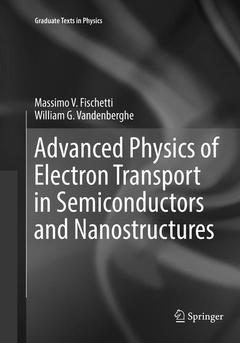Description
Advanced Physics of Electron Transport in Semiconductors and Nanostructures, 1st ed. 2016
Electronic Properties and Transport
Graduate Texts in Physics Series
Authors: Fischetti Massimo V., Vandenberghe William G.
Language: English
Subject for Advanced Physics of Electron Transport in Semiconductors...:
84.39 €
In Print (Delivery period: 15 days).
Add to cartPublication date: 05-2018
Support: Print on demand
116.04 €
In Print (Delivery period: 15 days).
Add to cartPublication date: 05-2016
474 p. · 17.8x25.4 cm · Hardback
Description
/li>Contents
/li>Biography
/li>Comment
/li>
Part I A Brief Review of Classical and Quantum Mechanics
- Lagrangian and Hamiltonian formulation of Classical Mechanics
- Superposition principle and Hilbert spaces
- Canonical Quantization
- Review of time-independent and time-dependent perturbation theory
- The Periodic Table, molecules and bonds in a nutshell
Part II Crystals and Electronic Properties of Solids
- Crystals: Lattices, structure, symmetry, reciprocal lattice
- The electronic structure of crystals
- Single-electron dynamics: Acceleration theorems, Landau levels, Stark-ladder quantization
Part III Second Quantization and Elementary Excitations in Solids
- Lagrangian and Hamiltonian formulation of classical fields
- Canonical Quantization of fields (‘Second Quantization’)
- An example: Quantization of the Schrödinger Field
- Elements of Quantum Statistical Mechanics and the Spin-Statistics Theorem
- Quantization of the charge density: Plasmons
- Quantization of the vibrational properties of solids: Phonons
- Quantization of the Electromagnetic Fields: Photons
- Dielectric properties of semiconductors
Part IV Electron Scattering in Solids
- Generalities about scattering in semiconductors
- Electron-phonon Interactions
- Scattering with Ionized Impurities: Brooks-Herring and Conwell-Weisskopf models, Ridley’s statistical screening, Friedel sum rule and partial-waves
- Coulomb interactions among free carriers, impact-ionization, Auger recombination
- Interfacial and line-edge roughness with examples: Si/SiO2, heterostructures, graphene nanoribbons
- Interfacial excitations with examples: III-Vs plasmon/phonon coupled modes, suspended grapheme
- Radiative Processes: The dipole approximation, absorption spectrum for III-Vs
Part V Electronic Transport
- The Density Matrix and the Liouville-von Neumann equation
- Overview of quantum-transport formalisms
- From Liouville-von Neumann to Boltzmann: The semiclassical limit.
Comprehensive treatment of electronic structure of and transport in solids including nanostructures
Includes a historical perspective on the evolution of quantum theory and how it has shaped our knowledge of electrons in crystals
Rigorous mathematical development is supplemented by numerical and computational methodologies which convey a practical understanding of the challenges and successes of using quantum mechanics for real world applications
Exercises for students, based on homework problems assigned by the authors, and suggested reading will be included
Includes supplementary material: sn.pub/extras

